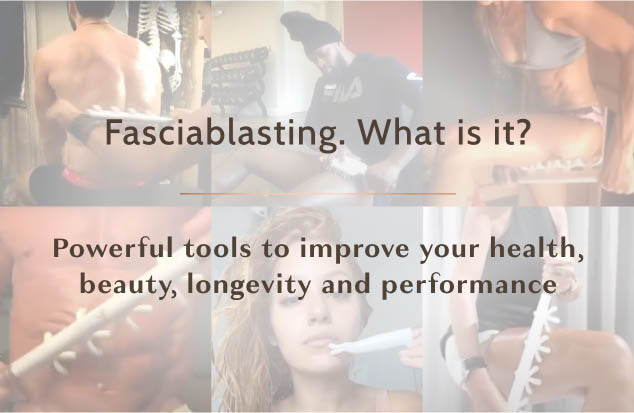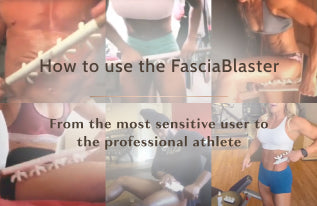Exploring The Facts: Can Ashley Black’s
Fasciablaster Make Cellulite Worse?
The FasciaBlaster’s Effects on Cellulite, Fascial
Adhesions, and Myofascial Release!
If we answer the question, does the FasciaBlaster* make cellulite worse by saying, “That is ridiculous,” does that make us snarky?




FasciaBlaster* is known for its miraculous effects* on smoothing skin, so why would this be in question? There is a section in my #1 National best-selling book CELLULITE; It’s Not Fat It’s Fascia called “Worse Before Better” where I explain that the process of FasciaBlasting isn't always pretty. Sometimes people bruise, sometimes we open Pandora's box of “what's hiding under the surface,” but science definitely shows that fascia gets better and better from day 1 of FasciaBlasting. And no one in the scientific research clinical study got worse. Check out some photos above with the coordinating ultrasounds, and you can see the cellulite smoothing at the skin’s surface and the fascia restoring deep below into the myofascial tissue.”
The process might be messy, but cellulite most certainly does not get worse when FasciaBlasting1, is incorporated, according to the study’s design. Click here to see more images from the research.
This animation shows the FasciaBlaster in use*
We Understand The Confusion
Understanding the nature of fascia is important because fascia is not just at the surface where we can see it in our skin’s texture. Fascia penetrates like a 3D web through the muscles. When Fascia becomes extremely tight, like the vacuum bag shown here, it chokes muscles out and leaves them unable to function properly. Kind of like beef jerky.

Now picture the beef jerky muscle and release the vacuum compression so the bag is larger or less compressed. What do you think is going to be revealed? A beef jerky muscle. This can look like loose or falling skin when, in reality, the beef jerky muscle has been revealed. If the fascia has been remodeled1 as we saw in the ultrasound, then the muscle can be freed to fire properly and condition or “plump” up to its natural strong state.
Our recommendation is to go little by little, layer by layer, and condition the beef jerky muscle all along the way. Going too hard, too fast, and not lifting weights or doing exercises to fire muscles causes this effect, not blasting techniques.*


Now, let’s dive into the science behind cellulite.
Cellulite, often referred to as “the appearance of dimples on the skin”, is a concern that countless individuals are always striving to work on, leading them on all types of quests for effective treatments, usually to no avail. Cellulite is generally perceived as “harmless,” but we beg to differ. There are different consensuses in the field of medicine on what exactly cellulite is, but, in a nutshell, cellulite is defined as the outward appearance of unhealthy fascia2, 3 and fascia is a vital system of the body, so we can’t let it slide and say love and accept your cellulite if unhealthy fascia is actually, unhealthy.


And if you search the internet for the causes of cellulite, you will find pages and pages of similar distorted misinformation. Where everyone needs to get on board and advance this understanding is that the “tough cords that pull down” and “fibrous bands … that tighten irregularly” are FASCIA. Tough and tight are just words that describe the condition of the fascia.
Hope That Clears Things Up!
Here’s What Else The Science Shows
The study's comprehensive design centered on investigating various physiological markers within 33 adult women, including hormones, inflammation, metabolism, subcutaneous fat, and most notably, the condition of the fascia. Over a span of 90 days, participants consistently utilized FasciaBlaster tools*, dedicating 20-minute sessions 3 to 5 times per week.
Here's what the research findings1 unveiled:
- Inflammation Reduction- Notably, the study demonstrated a decrease in C-reactive Protein (CRP), a systemic inflammation marker. The most substantial decline was observed within the initial 30 days, offering encouragement for individuals grappling with inflammation-related concerns.
- Collagen Boost - The study noted an increase in PICP markers for collagen production, a pivotal component constituting 30% of the body's protein. Collagen contributes to skin, muscle, bone, and connective tissue strength and structure.
- Hormonal Response - Serum Irisin Levels, a hormone typically associated with High-Intensity Interval Training (HIIT), displayed a significant rise. This suggests that the practice could potentially induce metabolic benefits similar to those seen in intense workout routines.
- Safety Assured - Crucially, the study did not identify spikes in markers indicating excessive strain on the body, affirming the safety of employing the FasciaBlaster tools.
- Localized Fat Reduction - Noteworthy was the decrease in subcutaneous fat at the site where FasciaBlasting occurred. Interestingly, this reduction transpired without a significant overall body fat decrease, supporting the notion of targeted fat reduction through FasciaBlasting.
- Cellulite Appearance Diminished - The study established a link between reduced cellulite appearance and the condition of deep tissue leg fascia. This connection hints at the potential of FasciaBlasting as a cellulite treatment via manipulation of the layers of the fascia.
- Fascia Remodeling - Ultrasound imaging provides visible evidence of collagen remodeling, or fascia remodeling, a regenerative process that returns collagen fibers to a native state. Remarkably, FasciaBlasting is uniquely non-invasive, producing this effect.

These insights emerged from a study conducted by the ASPI team in Tampa, Florida. The research underwent rigorous peer review before publication in the Cogent Medical Journal, underpinning the scientific validity of the findings. As we seek to discern the impact of FasciaBlasting on cellulite, these findings offer valuable insights into its potential positive effects on physiological markers related to cellulite appearance.
To read more about the research click here.
So It Can’t Make My Cellulite Worse?
NO! Fasciablasting does NOT contribute to the increase in cellulite. Nor does it contribute to sagging skin, hormone imbalance, or anything related to aging or damaging the skin. At Ashley Black, we prioritize transparency and public safety. We have subjected the FasciaBlaster tools to meticulous third-party testing and the peer-review process, ensuring that our responses to such inquiries remain unbiased and rooted in fact.

It's essential to remember that the study acknowledged, "Some subjects reported mild symptoms of irritability, nausea, headaches, and bruising. These were found to be minor, and all subjects did not report any long-lasting injury or illness to the research team." As you consider potential side effects associated with FasciaBlasting, remember this context and the study's assessment of these symptoms' mild and temporary nature.

See the FasciaBlaster Reviews
and photos for yourself
Check out real life use pics*
These amazing Before and Afters are directly from our users. These images showed undoubtable that cellulite only gets better and better with FasciaBlasting 1 and in ways never seen before!
More on the Science of Fascia

As Ashley explains, the pressure applied when using FasciaBlaster tools need not be forceful. In fact, the most effective outcomes arise from consistent and light usage. Visualize the layers of fascia and myofascial tissue as a multi-layered cake, with the icing representing the layers of fascia and the cake symbolizing the muscles beneath. In the initial stages of FasciaBlasting, concentrate on the uppermost layer of fascia, the cake's icing. The principle is to match the pressure exerted to the tool's weight, ensuring a harmonious interaction with your body's natural processes. To facilitate this, a small claw tool is most suitable.
Allow the skin to warm up and the blood flow to increase, temporarily enhancing circulation to the targeted area. You can do this by internally heating by exercising or externally heating like a sauna.

This natural process helps your body to open up easily. The FasciaBlasting procedure should induce mild discomfort or a pleasurable sensation, not pain. If discomfort arises, ease off the pressure or employ a Lymphatic Tip until sensitivity diminishes, then reattempt. As the topmost layer of superficial fascia starts to yield, progress by following the FasciaBlaster tools motion to the subsequent layer, applying slightly more pressure. Visualize this as transitioning from the cakes icing to its cake layers, or muscle, then the next layer of icing
FasciaBlasting* is an iterative process, fostering the gradual opening of fascia and myofascial tissue layer by layer. This approach, attuned to your body's signals, gradually increases depth with each session. The ultimate aim is to reach a point where deep blasting becomes pleasurable—a signal that the fascia tissue has been rejuvenated or was in a healthy state to begin with. Blasting only hurts if the fascia is suboptimal. Deep blasting is recommended with a large claw tool and a nugget tip. Click here to shop kits collection with various tips.
By adhering to this approach and allowing your body's responses to guide you, FasciaBlasting* can be a transformative practice that supports the restoration of your body's natural ability to heal.

So When You Ask the Question: Does FasciaBlasting Make Cellulite Worse?
Remember the answer is NO, it makes it better!
From user experiences to expert opinions1, the reality of this technique's effects on cellulite is palpable! As you continue on your journey toward well-being, may you always seek answers that resonate with your individual needs, aspirations, and desired results! We are here every step of the way. Send us your pictures for FREE coaching

Check out our Beginner Kit
designed with the beginner in mind.
-
 Fasciablaster - For deep myofascial blasting
Fasciablaster - For deep myofascial blasting
-
 Faceblaster - For sculpting the face and little spots, like the knees
Faceblaster - For sculpting the face and little spots, like the knees
-
 Nugget - Trigger point massage
Nugget - Trigger point massage
-
 Wrap Kryo Pack - For soothing Kryotherapy.
Wrap Kryo Pack - For soothing Kryotherapy.
-
 Blaster Oil®️ Essentials - Formulated with essential oils for a seamless Blasting experience.
Blaster Oil®️ Essentials - Formulated with essential oils for a seamless Blasting experience.
Cited Works
2. Cellulite - Symptoms and causes - Mayo Clinic
3. Cellulite: What It Is, Causes & Treatment
* The FasciaBlaster tools have not been cleared by the FDA for the treatment of cellulite
Authored by Ashley Black - Inventor of the FasciaBlaster

Ashley Black is a decorated inventor, thought leader and entrepreneur. She is best known for her work in the field of Fasciology. Fasciology is the study of the system of the body called fascia. Fascia is publicly known as the connective tissue, or web, that holds our body together, but fascia is also the viscous system that surrounds and feeds every cell in our bodies. Her work is directly related to the regeneration of this system of the body and the astounding effects this process can have on beauty, sports performance, and medical conditions.
She is best known for inventing instrument-assisted fascia techniques and tools, commercially known as FasciaBlasters. The tools entered the marketplace in 2014 and have become a household product. Black was the first person to write a #1 National Best Selling book about fascia, and she was the first person to do a TED Talk on fascia. By 2017-2018, her innovations and perseverance were rewarded with the American Business Association Stevie Award for Entrepreneur of the Year. IAOPT also awarded her with the Inventor of the Year. She also hit Inc’s Fastest Growing Companies in America for the first time. This era was wrapped up with Ashley’s self-reported highest accomplishment to date: the peer-reviewed Medical Publication of Research proving that FasciaBlasters can regenerate fascia tissue.
Since then, Ashley has received several awards, beginning with a second #1 National Best Selling Book about the struggles of females in business and authenticity in branding. She also received two global Stevie Awards from the International Business Association: Woman of the Year and a Lifetime Achievement Award for Consumer Goods.
In 2022, Ashley founded The Fascia Advancement Academy and the Fascia Advancement Charity to teach bodyworkers Fasciology. She has hit Inc’s Fastest Growing Companies list for a second time, with over $175MM in revenue, profitable and growing. She boasts over 9 million social media followers and over 1 trillion unique media impressions for her work. She plans to expand into the beauty, sports, and medical professional markets and create a billion-dollar business in the next two years.






